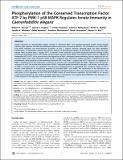Phosphorylation of the Conserved Transcription Factor ATF-7 by PMK-1 p38 MAPK Regulates Innate Immunity in Caenorhabditis elegans
Author(s)
Kim, Dennis H.; Matsumoto, Kunihiro; Hisamoto, Naoki; Shivers, Robert P.; Pagano, Daniel Joseph; Kooistra, Tristan G.; Richardson, Claire Elissa; Reddy, Kirthi C.; Whitney, Janelle Kristen; Kamanzi, Odile; ... Show more Show less
DownloadShivers-2010-Phosphorylation of t.pdf (596.3Kb)
PUBLISHER_CC
Publisher with Creative Commons License
Creative Commons Attribution
Terms of use
Metadata
Show full item recordAbstract
Innate immunity in Caenorhabditis elegans requires a conserved PMK-1 p38 mitogen-activated protein kinase (MAPK) pathway that regulates the basal and pathogen-induced expression of immune effectors. The mechanisms by which PMK-1 p38 MAPK regulates the transcriptional activation of the C. elegans immune response have not been identified. Furthermore, in mammalian systems the genetic analysis of physiological targets of p38 MAPK in immunity has been limited. Here, we show that C. elegans ATF-7, a member of the conserved cyclic AMP–responsive element binding (CREB)/activating transcription factor (ATF) family of basic-region leucine zipper (bZIP) transcription factors and an ortholog of mammalian ATF2/ATF7, has a pivotal role in the regulation of PMK-1–mediated innate immunity. Genetic analysis of loss-of-function alleles and a gain-of-function allele of atf-7, combined with expression analysis of PMK-1–regulated genes and biochemical characterization of the interaction between ATF-7 and PMK-1, suggest that ATF-7 functions as a repressor of PMK-1–regulated genes that undergoes a switch to an activator upon phosphorylation by PMK-1. Whereas loss-of-function mutations in atf-7 can restore basal expression of PMK-1–regulated genes observed in the pmk-1 null mutant, the induction of PMK-1–regulated genes by pathogenic Pseudomonas aeruginosa PA14 is abrogated. The switching modes of ATF-7 activity, from repressor to activator in response to activated PMK-1 p38 MAPK, are reminiscent of the mechanism of regulation mediated by the corresponding ancestral Sko1p and Hog1p proteins in the yeast response to osmotic stress. Our data point to the regulation of the ATF2/ATF7/CREB5 family of transcriptional regulators by p38 MAPK as an ancient conserved mechanism for the control of innate immunity in metazoans, and suggest that ATF2/ATF7 may function in a similar manner in the regulation of mammalian innate immunity.
Date issued
2010-04Department
Whitaker College of Health Sciences and Technology; Massachusetts Institute of Technology. Department of BiologyJournal
PloS genetics
Publisher
Public Library of Science
Citation
Shivers, Robert P. et al. “Phosphorylation of the Conserved Transcription Factor ATF-7 by PMK-1 p38 MAPK Regulates Innate Immunity in Caenorhabditis elegans.” PLoS Genet 6.4 (2010): e1000892.
Version: Final published version
ISSN
1553-7404
1553-7390